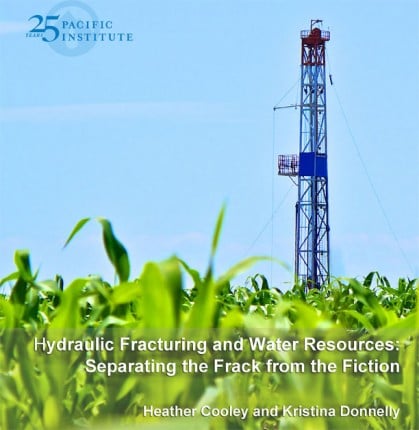“Hydraulic Fracturing and Water Resources: Separating the Frack from the Fiction”

View more images on our Flickr site
 Policymakers should be equally as concerned about wastewater spills and disposal issues related to shale gas extraction as they are about the possibility of groundwater contamination from fracking fluids according to a new report by Pacific Institute released last week. The report, “Hydraulic Fracturing and Water Resources: Separating the Frack from the Fiction,” interviewed a variety of stakeholders, which included representatives from agencies, industries, environmental organizations, and community organizations and asked them to identify a broad set of social, economic, and environmental concerns, with a specific focus on impacts hydraulic fracturing has on the availability and quality of water resources. Despite the different perspectives, there was “surprising agreement about range of concerns and issues associated with fracking” according to Heather Cooley, co-director of the Pacific Institute Water Program. The highest ranked concerns were spills and leaks, wastewater management, water withdrawals, air emissions, and water quality. Other issues included lack of information, stormwater and erosion, surface and mineral rights, and an agreeable definition of “fracking.”
Policymakers should be equally as concerned about wastewater spills and disposal issues related to shale gas extraction as they are about the possibility of groundwater contamination from fracking fluids according to a new report by Pacific Institute released last week. The report, “Hydraulic Fracturing and Water Resources: Separating the Frack from the Fiction,” interviewed a variety of stakeholders, which included representatives from agencies, industries, environmental organizations, and community organizations and asked them to identify a broad set of social, economic, and environmental concerns, with a specific focus on impacts hydraulic fracturing has on the availability and quality of water resources. Despite the different perspectives, there was “surprising agreement about range of concerns and issues associated with fracking” according to Heather Cooley, co-director of the Pacific Institute Water Program. The highest ranked concerns were spills and leaks, wastewater management, water withdrawals, air emissions, and water quality. Other issues included lack of information, stormwater and erosion, surface and mineral rights, and an agreeable definition of “fracking.”
While groundwater contamination is a significant environmental threat associated with fracking, the report suggests that there are other, arguably more pressing issues that also must be considered. For example, anecdotes suggest wastewater is regularly spilled en route to disposal wells, although no one keeps track of the information comprehensively, said Heather Cooley, author of the report and Co-Director of the Water Program at the Pacific Institute. “There is a lack of data and information on where fracking is happening, where the wastewater is going, where it’s being reused,” she said.
It is estimated that natural gas production will increase approximately 30% over the next twenty-five years, with the United States expected to be a net exporter of natural gas by 2021. The report highlights that increased exploration and drilling presents a variety of environmental threats, in addition to those caused by the process of fracturing shale, which must be addressed.
